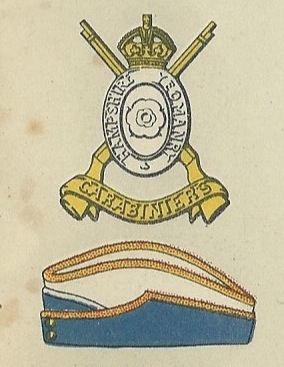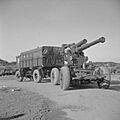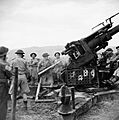Hampshire Yeomanry facts for kids
Quick facts for kids Hampshire Yeomanry |
|
|---|---|

Badge and service cap as worn at the outbreak of World War II
|
|
| Active | 1794 – present day |
| Country | |
| Branch | |
| Type | Yeomanry |
| Role | Cavalry Field Artillery Anti-Aircraft Artillery |
| Size | One Regiment |
| Engagements | Second Boer War World War I World War II |
| Battle honours | See below |
The Hampshire Yeomanry was a special cavalry group. It was formed by joining together older units from 1794 to 1803. These units were created during the French Revolutionary Wars. The Yeomanry served as soldiers on horseback in the Second Boer War and World War I. Later, they helped defend against air attacks during and after World War II.
Today, their history is carried on by two groups: 295 (Hampshire Yeomanry) Battery and 457 (Hampshire Carabiniers Yeomanry) Battery. These are part of the 106 (Yeomanry) Regiment Royal Artillery, which is part of the Army Reserve.
Contents
- Early Days: Protecting Britain (1794-1830)
- Becoming a Regiment (1830-1900)
- Fighting in the Boer War (1899-1902)
- Joining the Territorial Force (1908)
- World War I: Cavalry and Infantry (1914-1918)
- Between the Wars: Becoming Artillery (1920-1939)
- World War II: Defending Against Air Raids (1939-1945)
- After the Wars: New Roles (1947-Present)
- Uniforms and Badges
- Special Leaders
- Battle Honours
- Memorials
- Images for kids
- See also
Early Days: Protecting Britain (1794-1830)
Britain went to war with France in 1793. The Prime Minister, William Pitt the Younger, suggested a new idea in 1794. He wanted counties to create groups of volunteer cavalry called the Yeomanry. These groups would help defend the country if France invaded. They could also help local leaders keep peace if there was trouble.
Hampshire was one of the first counties to form a Yeomanry unit. Many independent troops were set up in Hampshire and the Isle of Wight. These groups were disbanded in 1802 when there was a short period of peace.
But the peace did not last long. Britain and France were at war again in 1803. The Yeomanry units in Hampshire quickly reformed to help protect the country once more.
Becoming a Regiment (1830-1900)
After the wars with France ended, the Yeomanry became less important. All the Hampshire Yeomanry troops were disbanded in 1828. However, new problems arose in 1830, leading to the Yeomanry being brought back. New independent troops were formed across Hampshire.
In 1834, several troops in north Hampshire joined together. They formed the North Hampshire Regiment of Yeomanry Cavalry. This was a big step, as they became a more organized unit.
By 1841, the regiment changed its style to Hussars, who were light cavalry. In 1848, they dropped 'North' from their name. Their main base moved to Winchester. In the 1850s, they added the Andover and Lymington troops.
In 1887, the regiment got a new name: Hampshire Yeomanry (Carabiniers). Carabiniers were soldiers who rode horses and used rifles. The regiment started using crossed carbines (a type of rifle) as their badge. By 1893, their troops were organized into squadrons. Their main base moved to Southampton, but later returned to Winchester.
Fighting in the Boer War (1899-1902)
In 1899, Britain was fighting the Second Boer War in South Africa. The government realized they needed more soldiers. They decided to let volunteer forces join the fight.
On December 24, 1899, the Imperial Yeomanry (IY) was officially created. Yeomanry regiments were asked to send companies of about 115 men each. Many British citizens volunteered to join this new force.
The Hampshire Yeomanry sent two companies to the Imperial Yeomanry:
- 41st (Hampshire) Company: This group arrived in South Africa in February 1900.
- 50th (Hampshire) Company: This group landed in Mozambique in May 1900.
These Hampshire companies served until 1901. Their service earned the regiment its first special honor: South Africa 1900–01. After the war, all Yeomanry regiments were called Imperial Yeomanry until 1907.
Joining the Territorial Force (1908)
In 1908, the Imperial Yeomanry became part of the new Territorial Force (TF). This was a new way to organize volunteer soldiers. The Hampshire Yeomanry trained as dragoons, who were cavalry soldiers.
Their main base was in Hyde Close drill hall, Winchester. They had squadrons (smaller groups of cavalry) in different towns like Portsmouth, Winchester, Southampton, and Bournemouth. The Hampshire Yeomanry was part of the TF's 1st South Western Mounted Brigade.
World War I: Cavalry and Infantry (1914-1918)
Mobilizing for War
The Hampshire Yeomanry was called into action at Winchester on August 4, 1914, when World War I began. Their commanding officer was Lt-Col J.E.B. 'Jack' Seely, who had been a government minister.
The Territorial Force was originally for defending Britain at home. But after the war started, TF units were asked to volunteer for 'Imperial Service' overseas. Men who volunteered for overseas service formed '1st Line' units. Those who stayed for home defense formed '2nd Line' units. A '3rd Line' was also created to train new soldiers.
1st Line: Fighting in France and Italy
The 1st Line regiment first helped defend Portsmouth. In March 1916, the regiment was split up. Its squadrons joined different British divisions heading to the Western Front in France.
- Regimental HQ and B Squadron landed in France in June 1916.
- A Squadron landed in France in January 1917.
- C Squadron landed in France in May 1916.
These squadrons often worked together as the IX Corps Cavalry Regiment. In July 1917, the Hampshire Yeomanry stopped being cavalry. They became infantry (foot soldiers) and joined the 15th (Service) Battalion, Hampshire Regiment.
This new battalion was called the 15th (Hampshire Carabiniers) Battalion, Hampshire Regiment. In November 1917, they moved to the Italian Front. They returned to the Western Front in May 1918 and fought there until the war ended.
2nd Line: Home Defence and Cyclists
The 2nd Line regiment was formed in Winchester in October 1914. They stayed in Britain for home defense. In July 1916, they changed their role. They became a Bicycle infantry unit, meaning they rode bicycles instead of horses.
They were part of the 6th Cyclist Brigade. Later, they merged with other units, sometimes called the 11th (Hampshire and Berkshire) Yeomanry Cyclist Regiment. By May 1918, they moved to Dublin, Ireland, where they remained until the end of the war.
3rd Line: Training New Soldiers
The 3rd Line regiment was formed in 1915. Their job was to train new soldiers to replace those fighting in the 1st and 2nd Line units. They were based at Tidworth and later Aldershot.
Between the Wars: Becoming Artillery (1920-1939)
After World War I, many Yeomanry regiments changed roles. The Hampshire Yeomanry became an artillery unit in 1920. They joined with another unit to form the 7th (Hampshire) Army Brigade, RFA.
In 1921, they were renamed 95th (Hampshire Yeomanry) Army Brigade, RFA. They used big guns called Royal Field Artillery (RFA). Their main base was in Winchester, with a battery (a group of guns) in Southampton.
Later, they became part of the 43rd (Wessex) Division. They had batteries in Winchester, Southampton, Bournemouth, and the Isle of Wight.
Switching to Anti-Aircraft Guns
In the late 1930s, as another war with Germany seemed likely, Britain needed better air defenses. So, in 1937, the 95th Field Brigade changed again. They became 72nd (Hampshire) Anti-Aircraft Brigade, Royal Artillery. From 1939, they were called an Anti-Aircraft Regiment.
Their main base moved to Southampton. They had anti-aircraft batteries in Winchester, Southampton, and Parkstone. Their new job was to shoot down enemy planes.
World War II: Defending Against Air Raids (1939-1945)
Protecting Portsmouth
The 72nd (Hampshire) AA Regiment was called into action on August 24, 1939, just before World War II began. They were part of the 35th AA Brigade, which protected the city and naval base of Portsmouth.
Battle of Britain and The Blitz
The regiment was very busy during the Battle of Britain in 1940. They fired their guns at German planes attacking Southern England. On August 18, their guns helped shoot down 23 enemy aircraft.
Portsmouth was a major target during The Blitz, when German planes bombed British cities at night. The regiment's guns were constantly in action. In one attack, bombs hit a gun position, killing soldiers and damaging equipment. But the remaining guns kept firing.
Fighting in North Africa
In January 1942, the 72nd (Hampshire) HAA Regiment prepared for service overseas. They trained for mobile operations. In October, they sailed from Britain as part of Operation Torch. This was the Allied invasion of North Africa.
The regiment's job was to protect landing beaches, ports, and airfields. They faced heavy attacks from German and Italian air forces. One of their ships, the SS Cathay, was sunk, and they lost some equipment. But they kept fighting.
At Bône, their anti-aircraft gunners fought off raids by Junkers Ju 88 bombers. Even after losing their radar, they used their guns to defend the area.
As the Tunisian Campaign continued, the regiment's guns were also used to fire at ground targets. This helped the infantry and tanks. In May 1943, they were among the first units to enter Tunis after the city was captured.
Serving in Italy
After North Africa, the 72nd (Hampshire) HAA Regiment moved to Italy. They helped defend the port of Naples from air attacks. Naples was a difficult city to protect, but the regiment worked with US and Italian units to set up strong defenses.
The German air force tried hard to stop supplies from coming through the port. On November 5, 1943, over 100 planes raided Naples. The anti-aircraft guns shot down four of them. The regiment stayed in Naples until October 1944. By then, the threat from enemy planes was much smaller. The regiment was officially disbanded on January 30, 1945.
After the Wars: New Roles (1947-Present)
In 1947, the Territorial Army was reformed. The Hampshire Yeomanry came back as the 295th (Hampshire Carabineers) Heavy Anti-Aircraft Regiment, RA (TA). Their main base was in Winchester.
In 1955, the AA Command was disbanded, and the regiment was put on hold.
It was brought back in 1963 and joined with another unit. They were renamed 457 (Wessex) Heavy Air Defence Regiment, RA (Hampshire Carabiniers Yeomanry). This was the longest name in the army! They changed from using traditional anti-aircraft guns to Thunderbird missiles. They even fired the last three Thunderbird missiles in the UK before they were retired.
In 1967, the regiment was disbanded again. But in 1992, the Hampshire Yeomanry returned as the 227 (Hampshire Yeomanry) Amphibious Engineer Squadron, part of the Royal Engineers. This role was short-lived.
After a defense review in 1999, the unit changed back to artillery. They became 457 (Hampshire Yeomanry) Battery in the 106 (Yeomanry) Regiment Royal Artillery. This battery was based in Southampton and used high-velocity missiles (HVM).
Under the Army 2020 plan, 457 (Hampshire Carabiniers Yeomanry) Battery got new equipment. They now use high-velocity missiles mounted on Stormer vehicles. Also, 295 (Hampshire Yeomanry) Battery was formed in Portsmouth with the same equipment. Both batteries are now part of the 106 (Yeomanry) Regiment.
Uniforms and Badges
The North Hampshire Yeomanry wore Hussar-style uniforms after 1841. These were fancy blue jackets with braid.
When they became 'Carabiniers' in 1887, they wore a Dragoon-style uniform. This included a blue tunic with white details. They wore a white metal helmet with a white horsehair plume. Their trousers had a white stripe.
Their special flag, called a guidon, had crossed carbines on it. It also had white roses and red roses. From 1920 to 1955, the Hampshire Yeomanry artillery batteries wore Yeomanry cap badges and buttons.
Special Leaders
The regiment had several important leaders called Honorary Colonels:
- Charles Shaw-Lefevre, 1st Viscount Eversley: A former leader of the regiment.
- Thomas Baring, 1st Earl of Northbrook: A former major in the regiment.
- Lt-Col Hon Sir Henry Crichton: A former commanding officer.
- Maj-Gen J. E. B. Seely, 1st Baron Mottistone: A former commanding officer, also known as 'Jack' Seely.
Battle Honours
Battle honours are special awards given to military units for their bravery in battles. The Hampshire Yeomanry earned these honors:
- Second Boer War: South Africa 1900–01
- First World War: Messines 1917, Somme 1918, St. Quentin, Bapaume 1918, Arras 1918, Ypres 1918, Courtrai, France and Flanders 1916–17 '18, Italy 1917–18
- Second World War: Battle honours are not given to Royal Artillery units.
Memorials
- A plaque in Winchester Guildhall lists the names of men from Winchester who served in the Second Boer War.
- Seventy-four members of the Hampshire Yeomanry are remembered on the Hampshire and Isle of Wight war memorial. This memorial is in Winchester Cathedral Close.
- The regiment's special flag, given by King Edward VII in 1909, was placed in Winchester Cathedral on November 6, 1955.
Images for kids
-
An AEC Matador artillery tractor pulling a 3.7-inch HAA gun during training in the UK.
See also
- Imperial Yeomanry
- List of Yeomanry Regiments 1908
- Yeomanry
- Yeomanry order of precedence
- British yeomanry during the First World War
- Second line yeomanry regiments of the British Army
- List of British Army Yeomanry Regiments converted to Royal Artillery





